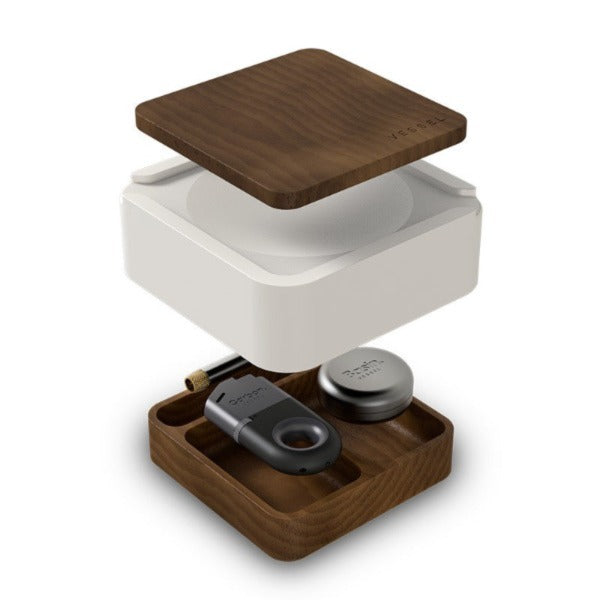
As cannabis legalization sweeps across the US, the number of dispensaries popping up has skyrocketed. This is largely due to the booming cannabis industry, which is expected to grow exponentially in the coming years. Entrepreneurs from all over are eager to tap into this lucrative market and create successful businesses.
If you've ever played with the idea of opening your own dispensary, you're not alone. As we all know, opening a dispensary isn’t easy, as there are numerous financial and legal hurdles to clear. But with the right planning and strategy, opening a dispensary can definitely be within your reach. In this article, we’ll guide you through everything you need to know to get your cannabis business off the ground.
How to open a dispensary step by step
- Step 1:Be aware of state and local regulations on cannabis.
- Step 2:Choose a location for your dispensary.
- Step 3:Create a business plan.
- Step 4:Estimate expenses and secure funding.
- Step 5:Register your business.
- Step 6:Apply for the necessary licenses and permits.
- Step 7:Build your dispensary.
- Step 8:Source from reputable suppliers and growers.
- Step 9:Hire workers for your dispensary.
- Step 10:Market your dispensary.
Opening a cannabis dispensary - How To
Step 1: Be aware of state and local regulations on cannabis.
Each state has its own set of rules and regulations. Start by researching the legal requirements in your state and local area, which includes understanding what licenses and documentation you’ll need to both start and run your dispensary. Figure out the specific regulatory bodies to comply with and their required process and paperwork.
To keep things organized, we recommend making a checklist of everything you need to do so you won’t miss anything important. Also, try to familiarize yourself with the penalties for non-compliance, as it can save you from many potential headaches down the road. Diligent preparation from the get-go can smooth out your path to opening day.
Step 2: Choose a location for your dispensary.
Picking the right spot for your dispensary is more than just choosing a place with lots of foot traffic. You also need to make sure you’re following local laws. To start, figure out the zoning regulations of your chosen location. Areas are usually zoned for specific uses like commercial, industrial, or residential, and you need to make sure your business fits the bill. For example, some states require dispensaries to be at least 1,000 feet away from schools, churches, or community centers.
Whether you’re planning to buy or lease your property also has different legal implications, so consider this carefully. On top of all the legal stuff, think about practical matters like accessibility, parking availability, and local competition. Find a spot that ticks all these boxes to maximize the success of your venture.
Step 3: Create a business plan.
This is the step where we lay the foundation for your entire operation. The more detailed your plan, the better prepared you'll be. Start by asking yourself some key questions:
- What kind of products will you carry—medicinal, recreational, or both?
- What are your initial costs for setting up the shop and the ongoing expenses once you're operational?
- How will you differentiate your dispensary from others in the area?
- Where you'll find your team and how will you train them?
- Where will your products come from, and how you ensure their quality?
- How will you promote your business, and which channels will be most effective for reaching your target audience?
There's a lot to consider. So, it’s important to sit down and develop a comprehensive business plan that covers all these aspects.
Step 4: Estimate expenses and secure funding.
Setting up a cannabis dispensary can be costly, and you'll need a solid financial plan to successfully launch and sustain your business profitably.
It’s important to be aware that some states require a certain amount of capital and liquid cash on hand before you can even open your doors. Think about your funding options: Will you use personal savings, seek help from family and friends, or try to attract investors? Remember, while cannabis may be legal in many states, most (if not all) traditional U.S. banks want nothing to do with financing cannabis ventures due to federal laws.
Additionally, factor in other significant costs like staffing, insurance, inventory, and equipment. Keep in mind the fees associated with applying for the necessary permits and licenses. By accounting for all these expenses upfront, you can set up a solid financial foundation for your business and avoid any unpleasant surprises.
Step 5: Register your business.
This is the part where you start to get creative. If you haven’t yet, think up of a catchy business name for your dispensary that sticks in customers' minds. Once you have a name, check if it's still available to ensure you don't run into trademark issues. Make sure to protect your intellectual property (names, logos, creative works, strands, etc.) under copyright laws.
When registering your business, decide whether to form an LLC or a corporation. Each option has different legal and tax implications, so make sure to research which structure best fits your operations.
Step 6: Apply for the necessary licenses and permits.
Before you can start selling cannabislegally, you need to get the right licenses and permits. Understand what specific permits are required in your area, and make sure you apply for all the necessary ones to operate a dispensary legally. You'll also need to stay on top of when and how to renew these documents to avoid any legal issues.
Additionally, register your business to pay state and possibly local taxes. Each state has its own tax laws, which can significantly impact how you conduct your business financially. Getting licensed might seem like a hassle, but it’s important for running your dispensary above board.
Step 7: Build your dispensary.
Now, it's time to get down to business and build out your dispensary.
First off, find a reputable contractor who understands the specific needs of a cannabis business and ensures compliance with all national and local building codes. When designing your space, consider the store layout, interior design, and how customers will flow through your dispensary. Make sure your technology setup supports your sales and inventory management efficiently. Additionally, product placement and parking are key factors contributing to a smooth customer experience.
Remember, how your store looks and feels will greatly influence your brand image and how customers perceive your business. A thoughtful, well-designed space can make a huge difference in their buying experience and overall impression of your brand.
Step 8: Source from reputable suppliers and growers.
Will you grow your own cannabis, or will you source it elsewhere? Regardless, both options require careful planning and compliance with local regulations.
If you’re planning to source, do due diligence when researching potential suppliers and growers to ensure they meet all legal standards and produce high-quality products. Establish strong relationships and negotiate the cost of your wholesale purchases effectively.
If you opt to grow your own, be mindful that this involves obtaining specific legal permits and licenses. Whether you buy or grow, it is important to maintain a reliable, legal, and high-quality supply chain that supports your dispensary's operations and enhances its reputation.
Step 9: Hire workers for your dispensary.
Your workers will be the heart of your operations, so hiring the right team is important for the success of your dispensary. Think about the roles you need to fill:
- How many workers and managers do you need?
- Will you need to hire security personnel?
- Will you need to hire an inventory manager?
- Are your operations tech-heavy enough to require IT staff?
Another thing to consider is competitive compensation and benefits that not only attract quality employees but also comply with local employment laws. Find staff that are knowledgeable and passionate about cannabis, as their expertise can enhance customer satisfaction and help your business stand out in a competitive market.
Step 10: Market your dispensary.
Once your dispensary is set up, the next step is to get the word out. Decide which marketing channels will best reach your target audience. Popular options include:
- Social media marketing, which can engage a broad community
- Email marketing for personalized offers
- Attending local events to connect with the community
- Listing your products on online cannabis platforms to reach a wider audience.
Also, don’t underestimate the power of word-of-mouth referrals. Encourage your friends, family, and satisfied customers to spread the word and utilize their networks to attract new customers to your dispensary.








Leave a comment (all fields required)